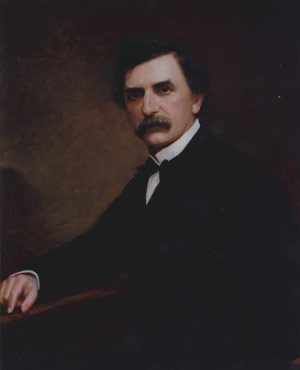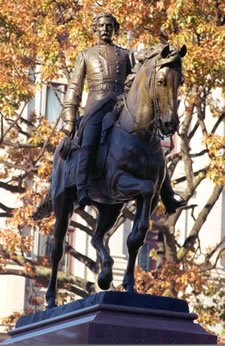Governor John Frederick Hartranft
Term
January 21, 1873 - January 21, 1879
Affiliation
Republican
Born
December 16, 1830
Died
October 17, 1889

Photo courtesy of Capitol Preservation
Committee and John Rudy Photography
Biography
Fondly remembered as "Old Johnny" by the rank and file of the troops he commanded, John Frederick Hartranft became the second of Pennsylvania's Civil War heroes to become governor after the war. He was born in New Hanover Township, Montgomery County, on December 16, 1830, the only child of Samuel Engle Hartranft, a landowner, and Lydia Bucher, both members of the Schwenkfelder religious group. Governor Hartranft's education, engineering background and Civil War record helped the governor to apply his self-guiding principle, "The more I have made of myself, the better I can help my fellows."
After Samuel purchased an inn in Norristown and branched out into real estate and stagecoach businesses, he was able to provide a better education for his son. John Hartranft briefly attended Marshall College in Mercersburg, Franklin County, before transferring to Union College in New York to study civil engineering, along with studies in arts and the classics. After graduating in 1853, he worked briefly as a civil engineer for the Mauch Chunk and Wilkes-Barre Railroad before accepting a position as a deputy sheriff in Norristown. There he soon became a lieutenant colonel in the militia and was admitted to the bar. In 1854, Hartranft married Sallie Douglas Sebring (1835-1914) of Easton, daughter of a judge, and with whom they had six children.
When the Civil War began, he was given command of the Fourth Pennsylvania Volunteers from Montgomery County. This regiment, comprised of ninety-day enlistees, humiliated Colonel Hartranft at the Battle of Bull Run on July 21, 1861, by walking away because their enlistments expired that same day. Although Hartranft stayed to fight, his personal reputation was called into question, until he commanded a new regiment by November, the 51st Pennsylvania Volunteers. Learning the lessons of the previous embarrassment, Hartranft gained the respect of his men. In December 1863, after a grueling campaign, relatively high loss of life, and facing new battles, Hartranft's men were again approaching the end of their enlistments. A speech by Hartranft extolling the virtues of the Union's grand cause is credited with the men reenlisting. Despite his reputation of good judgment through twenty-three battles, Hartranft was not promoted to general until after his forces crushed the last significant counterattack by the Confederate army in March 1865.
Next assigned as the provost marshal of Washington Arsenal prison, it was Hartranft's responsibility to signal the executioner to carry out the death by hanging sentence of the four Lincoln assassination conspirators. By then, however, he decided to end his military career.
 Having switched from the Democratic to the Republican Party, he was an early associate of the Simon Cameron political machine, serving as auditor general under Governor Geary from 1866 to 1873. He became Cameron's personal choice to succeed John Geary as governor and defeated Charles B. Buckalew in the election of 1872. The end of the industrial boom that supported the Civil War and the Panic of 1873 brought economic decline which lingered on in Pennsylvania through both Governor Hartranft's terms, but he was able to keep state finances stable. In contrast to Governor Geary, he had no objection to the expanding influence of the Pennsylvania Railroad and other industrial interests, although he did advocate improved opportunities for laborers by way of vocational education.
Having switched from the Democratic to the Republican Party, he was an early associate of the Simon Cameron political machine, serving as auditor general under Governor Geary from 1866 to 1873. He became Cameron's personal choice to succeed John Geary as governor and defeated Charles B. Buckalew in the election of 1872. The end of the industrial boom that supported the Civil War and the Panic of 1873 brought economic decline which lingered on in Pennsylvania through both Governor Hartranft's terms, but he was able to keep state finances stable. In contrast to Governor Geary, he had no objection to the expanding influence of the Pennsylvania Railroad and other industrial interests, although he did advocate improved opportunities for laborers by way of vocational education.
In the election of 1875, in which Hartranft won by a narrow margin over Democrat Cyrus L. Pershing, a rumor arose that he had made and broken a promise to pardon Jack Kehoe, thus commuting the death sentence of the infamous Molly Maguires leader who had been convicted of perpetrating clandestine murders in the anthracite-mining region. It was said that the governor promised to do this if the anthracite communities, particularly in Schuylkill County, voted for his reelection. No convincing evidence of such an agreement was found and Hartranft ignored the convicts' clemency pleas. Kehoe was hanged before a large crowd in Pottsville on December l8, l878. Although he lost Schuylkill County, Hartranft did carry the precinct in which Kehoe had resided.
The great railroad strikes of 1877, a national movement, spread throughout Pennsylvania's railroad cities and caused dozens of deaths, millions of dollars in riot damage, and the need to call in federal troops to supplement the state's National Guard units. Critics in Pittsburgh later claimed that the governor's decision to use federal troops in Pittsburgh actually incited riots, but Hartranft pointed his finger at local sheriffs and accused them of neglect in not curtailing the rioters. Still, Hartranft had a dream of a smoothly functioning industrial democracy with reasonable opportunity for manual laborers to rise through their own efforts. He sought knowledge about labor relations from European experience, proposed recognition of labor unions, and the arbitration of claims. He helped western Pennsylvania improve river commerce and draw attention to the emerging and lucrative new oil industry. He also created the Insurance Department to protect policyholders, supported state hospitals for the insane, advocated municipal reform, and implemented the changes brought about the state Constitution of 1874. Hartranft's first term in office had been under the Pennsylvania Constitution of 1838 and his second term was under the Constitution of 1874.
After leaving office, he headed the Pennsylvania National Guard and implemented several reforms of its system. He was appointed postmaster of Philadelphia and later collector of the Philadelphia Port. Tall, lean, and muscular, Hartranft had a dignified presence but was not an outstanding public speaker.
At least as early as 1873, he had a condition of uremia, known as Bright's Disease, which damaged his kidneys and ultimately led to his death on October 17, 1889. Hartranft was buried in Montgomery Cemetery, Norristown. Ten years after his death, a heroic bronze, mounted statue of him was dedicated on the grounds of the Pennsylvania State Capitol with Civil War veterans turning out en masse. It can be seen there today near south side of the building.
Pages in this Section
- 1790-1876
- Thomas Mifflin
- Thomas McKean
- Simon Snyder
- William Findlay
- Joseph Hiester
- John Andrew Shulze
- George Wolf
- Joseph Ritner
- David Rittenhouse Porter
- Francis Rawn Shunk
- William Freame Johnston
- William Bigler
- James Pollock
- William Fisher Packer
- Andrew Gregg Curtin
- John White Geary
- John Frederick Hartranft